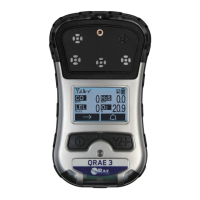35
10.3. Zero Calibration
This operation sets the zero point of the sensor calibration curve for clean air. It should be
performed before other calibrations.
Note: If you use a zero air cylinder, you must use the QRAE 3 Calibration Adapter (and a T
calibration tube if the instrument has a pump). Using a calibration adapter is not necessary for
calibration in fresh air.
10.3.1. Zero Calibration
This procedure determines zero points of most sensors. The QRAE 3 should be zero-calibrated in
clean air with 20.9% oxygen or with a cylinder of clean zero air.
At the Calibration menu, select “Fresh Air” by pressing [Y/+] once to enter fresh air calibration.
After a timer countdown, the zero calibration is done. The LCD displays the sensor names and
tells you whether each calibration passed or failed, followed by the sensor readings.
Note: You can abort the calibration at any time during the countdown by pressing [MODE].
10.3.2. Single-Sensor Zero Calibration
Select the sensor and then start the calibration by pressing [Y/+]. You can abort the procedure
anytime by pressing [MODE].
10.4. Span Calibration
This procedure determines the second point of the sensor calibration curve for the sensor.
Note: When a manual calibration is performed, the readings shown are in the equivalent
units of the calibration gas, and not the measurement gas.
10.4.1. QRAE 3 Pumped Model
The QRAE 3 pump draws at a flow rate of between 200cc/min and 450cc/min. The
instrument must be connected to a cylinder of calibration gas with supplied tubing
featuring a T calibration tube (P/N M02-3008-000), as illustrated below.
Note: A constant-flow regulator with flow rates from 500cc/min to 1000cc/min should be used.
Note: Make sure pressure in
the calibration gas cylinder
is higher than 100 psi when
using a T calibration tube.

